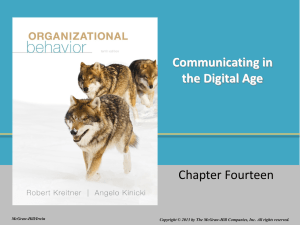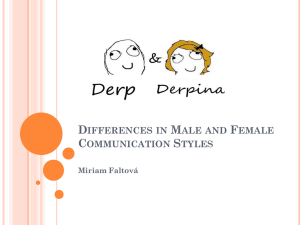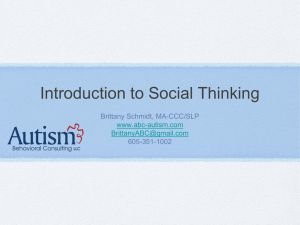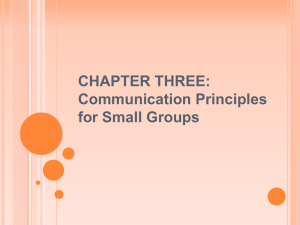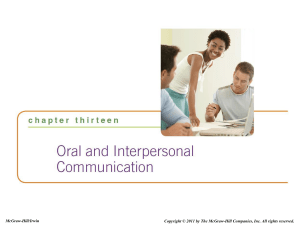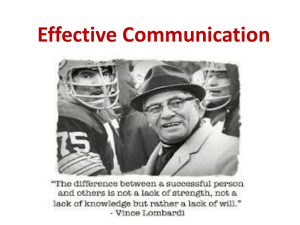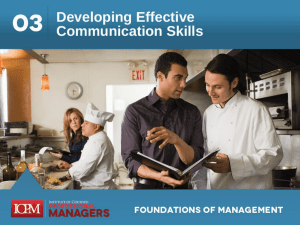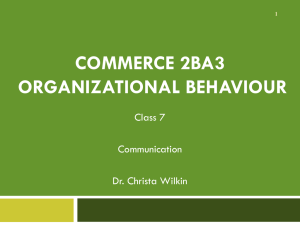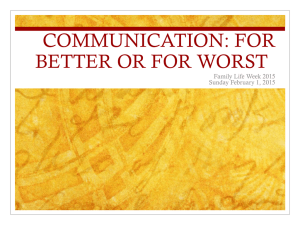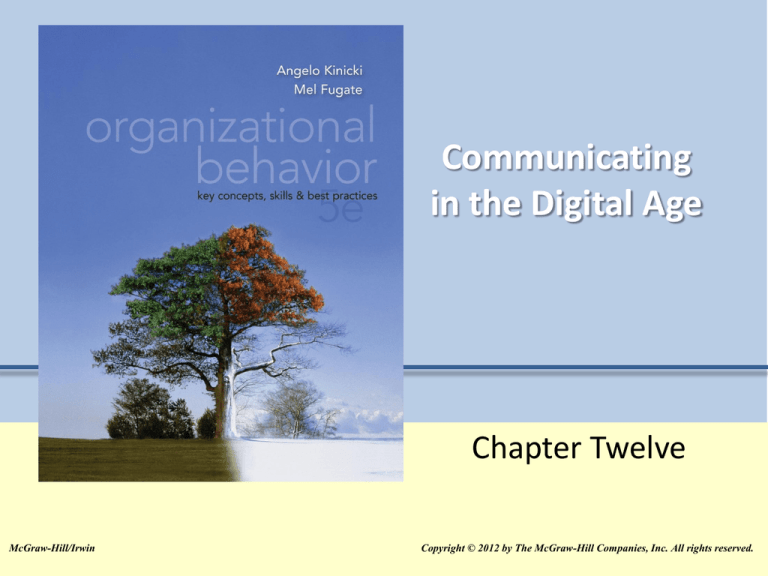
Communicating
in the Digital Age
Chapter Twelve
McGraw-Hill/Irwin
© 2012 The McGraw-Hill Companies, Inc. All rights reserved.
Copyright © 2012 by The McGraw-Hill Companies, Inc. All rights reserved.
After reading the material in this chapter,
you should be able to:
LO12.1 Describe the perceptual process model
of communication
LO12.2 Describe the process, personal, Physical,
and semantic barriers to effective
communication
LO12.3 Contrast the communication styles of
assertiveness, aggressiveness, and
nonassertiveness
LO12.4 Discuss the primary sources of
nonverbal communication
12-2
After reading the material in this chapter,
you should be able to:
LO12.5 Review the five dominant listening styles
and 10 keys to effective listening
LO12.6 Discuss the impact of information
communication technologies (ICT) on
productivity
LO12.7 Describe the challenges of managing
teleworkers, and the advantages and
concerns associated with social media at
media
12-3
Basic Dimensions of the
Communication Process
Communication
the exchange of information between a sender
and receiver and the inference (perception) of
meaning between the individuals involved
12-4
Communication Process in Action
12-5
A Perceptual Model of
Communication
Sender
person wanting to communicate information-the
message
Receiver
person, group, or organization for whom the
message is intended
Encoding
translates thoughts into code or language that
can be understood by others
12-6
Question?
Alexa is informing her subordinates that the
expense reimbursement policy for travel has
been significantly modified. Alexa would be
considered which of these?
A.Decoder
B.Medium
C.Sender
D.Noise
12-7
A Perceptual Model of
Communication
Selecting a Medium
depends on the nature of the message, its
intended purpose, type of audience, proximity
to the audience, time horizon for disseminating
the message, personal preferences, and the
complexity of the problem/situation at hand
12-8
A Perceptual Model of
Communication
Decoding
occurs when receivers receive a message
process of interpreting and making sense of a
message
Feedback
receives expresses a reaction to the sender’s
message
12-9
A Perceptual Model of
Communication
Noise
interference with
the transmission
and understanding
of a message
12-10
Communication Barriers within the
Communication Process
12-11
Barriers to Effective
Communication
1. Personal barriers
any individual attribute that hinders
communication
2. Physical barriers
3. Semantic barriers
12-12
Personal Barriers
1. Variable skills in communicating effectively
2. Variations in how information is processed
and interpreted
3. Variations in interpersonal trust
4. Stereotypes and prejudices
5. Big egos
12-13
Personal Barriers (cont.)
6. Poor listening skills
7. Natural tendency to evaluate other’s
messages
8. Inability to listen with understanding
9. Nonverbal communication
12-14
Physical Barriers
Time zone differences
Telephone-line static
Distance from others
Crashed computers
Office design
12-15
Question?
Laura works at an office with low-walled
cubicles. There is often a lot of background
noise and Laura has trouble hearing clients
on the phone. This is an example of a
________ barrier.
A.Process
B.Physical
C.Personal
D.Semantic
12-16
Barriers to Effective
Communication
Semantics
study of words
Semantic barriers
problems with language in communication
fueled by the growing trend to outsource
customer service operations to foreign
countries like India
12-17
Barriers to Effective
Communication
Jargon
represents language or terminology that is
specific to a particular profession, group, or
company
12-18
Interpersonal Communication
Communication
competence
performance-based
index of an
individual’s abilities
to effectively use
communication
behaviors in a given
context
12-19
Communication Competence
Affects Upward Mobility
12-20
Assertiveness, Aggressiveness, and
Nonassertiveness
Assertive style
expressive and self-enhancing, but does not
take advantage of others.
Aggressive style
expressive and self-enhancing, but takes unfair
advantage of others
Nonassertive style
timid and self-denying behavior.
12-21
Question?
Sunil has an expressive and self-enhancing
communication style, which is based on the notion
that it is not right or good to violate our own or
others' basic human rights. Sunil can be
described as having which of these styles?
A.Aggressive
B.Nonassertive
C.Nonverbal
D.Assertive
12-22
Communication Styles
12-23
Sources of Nonverbal
Communication
Nonverbal Communication
any message, sent or received independent of
the written or spoken word
includes such factors as use of time and space,
distance between persons when conversing,
use of color, dress, walking behavior, standing,
positioning, seating arrangement, office
locations and furnishings.
12-24
Sources of Nonverbal
Communication
Body movement
and gestures
Touch
Facial expression
Eye contact
12-25
Question?
Travis was in a meeting with his supervisor
regarding sales analysis. Travis had his
arms folded and legs crossed. Travis's
nonverbal behavior communicated which of
these?
A.Semantics
B.Defensiveness
C.Aggressiveness
D.Immediacy
12-26
Active Listening
Listening
Process of actively decoding and interpreting
verbal messages.
12-27
Listening Styles
Appreciative
listens for pleasure, entertainment, or
inspiration
Empathetic
interprets messages by focusing on emotions
and body language
12-28
Question?
Dr. Philip interprets messages by focusing
on emotions and body language. His
listening style can be described as
__________.
A.Appreciative
B.Empathetic
C.Discerning
D.Evaluative
12-29
Listening Styles
Comprehensive
organizes specific thoughts and actions and
integrates this information by focusing on
relationships among ideas
12-30
Listening Styles
Discerning
attempt to understand the main message and
determine important points
Evaluative
listen analytically and continually formulate
arguments and challenges to what is being said
12-31
The Keys to Effective Listening
12-32
Managing Teleworkers
Teleworkers
People who fulfill some portion of typically
office-based job responsibilities outside the
office via ICT
also known as telecommuters and distributed
workers
12-33
Managing Teleworkers
Gatekeeping
Monitoring
Work-life
boundary
management
Social
integration
Work group
culture
12-34
E-Mail: Benefits, Drawbacks, and
Suggestions for Managing It
12-35
Social Media at Work
Social media
uses Internet-based and mobile technologies to
generate interactive dialogue with members of
a network.
12-36
Motives that Affect Participation in
Social Networking
Community membership
benefits of belonging to a group
Friendship connections
efficiently interacting with friends
Information value
access to the knowledge and experience of
others
12-37
Motives that Affect Participation in
Social Networking
Participation confidence
fear of looking bad to a large number of people
Participation concerns
privacy and being scammed
12-38
Company Requirements for Social
Media
1. Establish a no privacy policy
2. Maintain boundaries between personal and
professional
3. Monitor the Internet
12-39
Video: A Week Without
Technology: Could You Do It?
What business processes are affected by the presence or
lack of technology? Is it possible for a company to be
competitive today without technology?
How is the perceptual model of communication different
when technology is used than if it were not? Which types
of communication barriers might be different?
How are the non-verbal aspects of communication affected
by technology?
How would you do in Dennis’s situation - could you have
lasted the full week?
12-40

